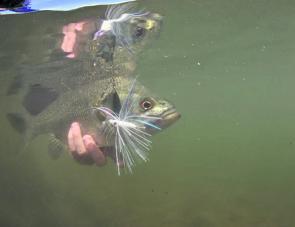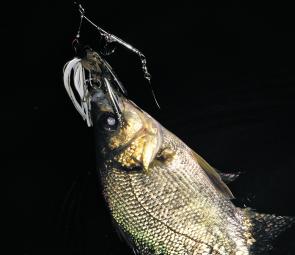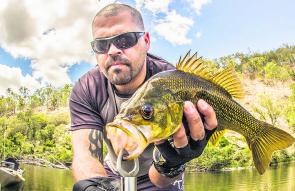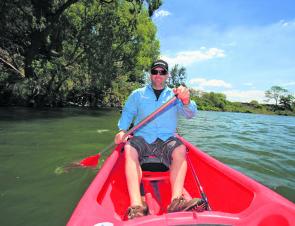The Macleay River system originates well inside the Armidale Shire, and flows uninterrupted for nearly 300km to the sea at South West Rocks. A healthy population of Australian bass inhabit a large percentage of this waterway, from the tiny creeks in the upper Macleay to the tidal zones of Kinchela Creek.
Bass are an iconic Australian species and are largely catch-and-release throughout this region. Working in the local tackle shop in Kempsey, I am constantly reminded of the diverse range of anglers that target these fish, and the mild obsession some have with the species.
I feel the main attraction to bass fishing is that it is well within reach of people from all works of life and the Macleay caters for all demographics nicely.
The upper reaches of the river also play host to some quality bass orientated lodges that can cater for groups and provide expert guides.
Due to private property constraints, large sections of the riverbank are inaccessible without prior consent from landowners. Public access to the upper Macleay is available at Georges Junction, Blackbird Flat and Bellbrook Bridge. Moving down from Bellbrook through to Kempsey, most roads off to the right will lead to a bridge crossing the river. These bridges not only provide direct access to the water, but are also a fishing haven. Flood debris in the form of branches and trees are quite often caught up around the bridge pylons and can hold some solid fish.
To maximise the full potential of bass fishing in the Macleay, a canoe or kayak is highly recommended. A common practice is to start the day out at 1 of the bridge crossings, paddle upstream as far as you desire, and then let the flow of the river take you back to where you started. Depending on river levels, you may encounter shallow areas where you may have to carry your boats, or high flowing rapids that could require boats to be carried. Heading upstream first means you have already covered the stretch of river you will be fishing, making you aware of any obstacles or dangers lurk so there’s no nasty surprises. If planning to do a trip from 1 bridge to another, it is worth consulting a topographical map or attain some local knowledge, as in all cases the distance by road is only a fraction of the same trip by water. Careful planning will ensure you don’t get caught on the river after dark.
Belgrave Falls, located just above Kempsey, marks the top of the tidal zone. This shallow series of rapids is unpassable to all but the smallest of craft, and acts as a boundary of where canoe and kayak numbers decrease and powered boats start. The Kempsey section of the river is serviced by 3 main boat ramps located at Greenhill, the rail bridge in Kempsey, and also one in Riverside Park in Kempsey’s CBD.
Deep, long holes are quite common along this section of the river, making it relatively easy to navigate by boat. Adjacent to these holes lie plenty of overhanging trees, eroded banks, snags, weed beds, and even shallow gravel areas, so there is plenty of awesome fishing terrain located within a stone’s throw of the most highly populated area along the river.
The pylons of Kempsey’s 2 bridges provide deep holes, and huge schools of smaller bass can be found here early and late in the bass fishing season. There are plenty of land-based options throughout the Kempsey township; we have even been known to duck down under the bridge during our lunch break and nail some solid fish in the middle of the day!
The newly constructed freeway bridge just downstream from Frederickton has created a very popular bass fishing spot, which is serviced by a new boat ramp only a few hundred metres away. The close proximity of the ramp makes the bridge pylons easily accessible to kayaks and small boats.
Belmore River, Smithtown Bridge and further downstream to Kinchela Creek mark the lowest points in the system where bass are consistently found. The boat ramp alongside Smithtown Bridge provides easy launching for small to medium sized boats and has a good wharf, so single-handed launching is possible. Belmore River is only a few minutes away upstream, with Kinchela Creek about 10 minutes downstream. These areas become heavily populated with spawning fish during the winter closed season months, however, they do hold some cracking resident fish year-round. Being well into the tidal zone, bycatch of bream, whiting, school mulloway and flathead are very common when targeting bass in these areas.
Bass are a very aggressive species and respond well to a variety of lures and baits. During the warmer months, surface lures are the go-to options. As in all forms of fishing, it pays to match the hatch. Cicada imitation lures are highly effective during these periods, and are almost irresistible to feeding fish. Deep diving lures and spinnerbaits come into their own during cooler periods and through the middle of the day. Dark colours, including black, purple and olive seem to draw the most strikes, but sometimes it is about the action of the lure rather than the colour.
For anglers looking to catch bass using bait, earthworms and live shrimp fished under a float or just drifting unweighted along with the flow will snare plenty of fish.
When selecting an outfit for chasing Australian bass, you need to choose a rod with an appropriate cast weight for the lures in use. Shorter rods between 5’6” and 6’6” in about the 2-4kg range are the most popular, as they allow you to get under over-hanging branches and have plenty of power in the bottom end to pull fish away from snags. Small threadline reels spooled with 6-10lb braid will do the job nicely, allowing lures of all sizes and weights to be cast. Leader size can vary depending on the structure you are fishing, however, 10-15lb mono or fluorocarbon will suit most scenarios.
Reads: 9199
A healthy bass taken from a shallow gravel area around Kempsey on a spinnerbait.

Bass are highly active before and after sunset.

Tim Meehan used his kayak to access a secluded hole and found this solid Macleay bass.

Catch and release is common practice on the Macleay.

The Macleay has plenty of places to fish, even in a 20kt southerly.




